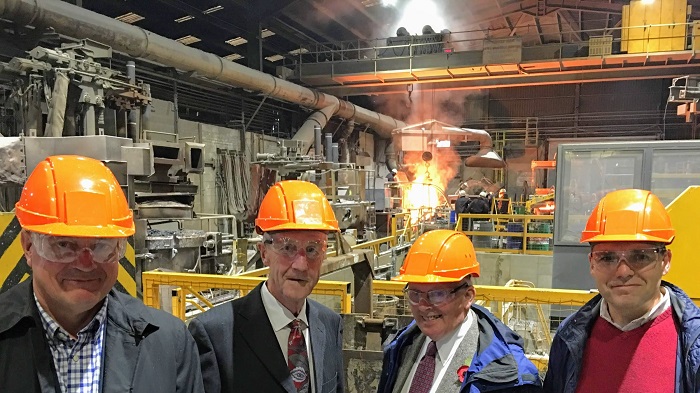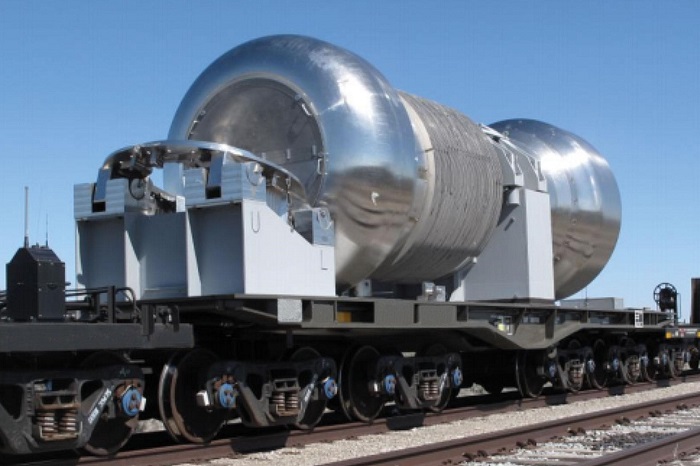11 shares for the future
9th November 2018 15:47
by Richard Beddard from interactive investor
Having visited the foundry, companies analyst Richard Beddard puts the stock ranked number one by his Decision Engine in the spotlight.

Before I report on a visit to Goodwin, I have made a minor change to the presentation of the Decision Engine's output.
Confidence trick
As usual the most attractive shares for long-term investment head the list, and the least attractive have sunk to the bottom. But from now on the scores in the second column will be rounded to two significant figures, rather than one.
I use these scores to guide my personal dealings and a model portfolio for our sister magazine Money Observer (the Share Sleuth portfolio). If a share scores seven or more, I consider it a "buy", and if it scores less than five I consider it a "sell". Although these are arbitrary levels I do not always obey, rounding to one significant figure obscured them because a company scoring, say 6.7, would receive a score of seven.
The score is based on my assessment of a business and its share price, whether it is profitable, adaptable, resilient, equitable and cheap. You can see the system in action in my weekly articles for interactive investor.
While I try to be objective, the table is not an objective measure of a company's suitability for investment. It is more like a measure of confidence because the scores are determined by judgement and there is always a degree of uncertainty. The Decision Engine says I am 90% confident Goodwin or XP Power will deliver superior returns to shareholders over ten years or more, but I am only 50% confident MS International will, which feels about right.
The more confident I am, the more money I am prepared to put at risk in a share, up to a maximum of 10% of the value of a portfolio in the unlikely event a company scores a perfect ten. My ideal portfolio is, therefore, weighted towards the shares near the top of this list:
| Name | Score | Description |
|---|---|---|
| Goodwin | 9.0 | Casts and machines steel. Processes minerals for casting jewellery, tyres |
| XP Power | 9.0 | Manufactures power adapters for industrial and healthcare equipment |
| Solid State | 8.0 | Manufactures rugged computers, batteries, radios. Distributes components |
| Trifast | 7.8 | Manufactures and distributes nuts and bolts, screws, and rivets |
| Dewhurst | 7.7 | Manufactures pushbuttons and other components for lifts and ATMs |
| Howden Joinery | 7.6 | Supplies kitchens to small builders |
| Next | 7.6 | Retails clothes and homewares |
| Cohort | 7.5 | Manufactures military tech. Does research and consultancy |
| FW Thorpe | 7.3 | Makes light fittings for commercial and public buildings, roads, tunnels. |
| Dart | 7.2 | Flies holidaymakers to Europe. Trucks fruit and veg around the UK |
| Castings | 7.0 | Casts and machines components for heavy trucks and other vehicles |
| Games Workshop | 6.9 | Manufactures, retails Warhammer miniatures for collectors, gamers |
| Quartix | 6.9 | Designs vehicle tracking systems for small fleets and insurers |
| Judges Scientific | 6.8 | Buys and operates small scientific instrument manufacturers |
| Victrex | 6.8 | Manufactures PEEK, a tough, light and easy to manipulate polymer |
| Renishaw | 6.8 | Whiz bang manufacturer of automated machine tools and robots |
| James Halstead | 6.8 | Manufactures vinyl flooring for commercial and public spaces |
| Alumasc | 6.7 | Designs and supplies roofing, walling, drainage and solar shading |
| Science | 6.5 | Buys and operates small scientific instrument manufacturers |
| Porvair | 6.2 | Manufactures filters and filtration systems for fluids and molten metals |
| Churchill China | 6.2 | Manufactures tableware for restaurants and eateries |
| Anpario | 6.2 | Manufactures natural feed additives for livestock |
| Colefax | 6.1 | Designs luxury fabrics, supplies them to interior designers |
| Avon Rubber | 6.1 | Manufactures respiratory protection and milking equipment |
| Portmeirion | 6.1 | Designs and manufactures tableware, candles and reed diffusers |
| Hollywood Bowl | 6.1 | Operates tenpin bowling centres |
| Walker Greenbank | 6.0 | Fabric and wallpaper designer and manufacturer |
| Motorpoint | 5.9 | Retails nearly-new cars through car supermarkets |
| Ricardo | 5.8 | Provides engineering and environmental services and builds engines |
| Treatt | 5.6 | Sources, processes and develops flavours esp. for soft drinks |
| Finsbury Food | 5.6 | Bakes cakes, bread, croissants, and pies for supermarkets and cafes |
| Tristel | 5.5 | Manufactures disinfectants for simple medical instruments and surfaces |
| Vp | 5.4 | Rents out specialist equipment and tools |
| Air Partner | 5.1 | Brokers air charters and provides services |
| MS International | 4.9 | Manufactures naval guns, forklift blades and petrol station forecourts |
| System1 | 4.7 | Tests our emotional response to advertisements and concepts |
Re-rating Goodwin
My confidence in Goodwin, now the top ranked share, received a boost on Wednesday when I visited a number of the company's factories with three other shareholders. I reviewed and scored Goodwin soon after it published its annual report in September.
The numbers indicated its financial performance had stabilised after three years of subdued demand for oil and gas pipeline valves. The chairman's report brimmed with confidence about the future, and not just because oil prices have been rising and oil companies are likely to start investing again.
While orders were low and the foundry was quiet, Goodwin upgraded it. Goodwin Steel Castings can now cast products weighing up to 35 tonnes, putting it in a league, the company says, of only a handful of foundries worldwide.
Simultaneously, Goodwin secured accreditations and a $19.5 million contract supplying the US Navy's submarine programme, the first, it believes, of many.
Visiting Goodwin's factories seemed like a good way to learn more about the business, and dress up in an orange hard hat and protective eye gear:

Photo: Richard Beddard (red jumper) with shareholders
Perhaps the most impressive thing we saw was not the pouring of molten steel in the photograph. It was a small two tonne pouring sandwiched in between a much bigger one in the morning and the busy night shift when electricity is cheaper and the foundry is busier.
I was most impressed by 16 tonne bowls used to cap containers transporting spent nuclear fuel rods very similar to the ones in this photograph:

Photo: A Department of Defense train hauling a spent nuclear fuel cask. Credit: U.S. Department of Energy
We saw one being machined on the biggest machine I have ever seen, bought nearly-new from a Korean shipbuilder.
John and Richard Goodwin, the company's chairman and chief executive, showed us many portents of prosperity as we walked from unit to unit: The new quenching pit, required to harden heavier casts, the prospect of a seemingly unending stream of Virginia class submarines planned by the US navy, a vacant site adjacent to Goodwin International being prepared for a secret defence-related project, a new patented axial valve, and the possibility EASAT, Goodwin's radar division, might become a significant contributor of revenue now it is manufacturing whole radar systems for air traffic control and coastal surveillance.
In deciding whether these projects and programmes will bring prosperity again, the past may be instructive. Decades ago Goodwin, when it manufactured tyre making machines, almost went out of business.
Durable radial tyres replaced easily worn out cross-ply tyres, the number of UK tyre factories halved, and tyre companies located factories in lower cost economies.
That was when Goodwin pivoted into slurry pumps and valves, the businesses that have helped it grow so rapidly since. I should say, it also diversified into mineral supply, principally for jewellery casting, a part of the Goodwin we did not visit.
Goodwin's performance would have been much worse following the oil price slump had it not been for this Refractory Engineering division.
Components for ships lie side by side with slurry pumps, valves and antennae for air traffic control systems on the factory floor.
Goodwin has metallurgical know how, a willingness to invest for the long-term and a nose for profit, that leads it into many markets.
It secures high profit margins by supplying bespoke projects with demanding specifications it says few other companies can match, and developing patented products rivals cannot copy.
It is finding new business in the USA, where it currently earns a tiny proportion of total revenue, because so many foundries have closed and the USA cannot supply its own shipbuilding programme.
Once the skills are lost, the brothers say, it is very hard to regain them and a British supplier may well be more acceptable on quality and security grounds than a Chinese one.
I'm not an economist, so take this with a pinch of salt. John Goodwin bridles at the widespread belief that British manufacturing is inefficient.
Large markets mean a steady stream of projects, he says, which makes manufacturers of capital goods like Goodwin International and Goodwin Steel Castings, more efficient. That makes me think about the size of the US market because the brothers talk about it almost as though it is a home market.
Skills are being retained at Goodwin. Four sons of Richard and John sit on the Goodwin board. Three of them are engineers and the fourth is an accountant. The family factor is a crucial one, I think, in deciding whether to invest in Goodwin. On one hand family control could be a sclerotic influence promoting Goodwin DNA regardless of merit. On the other hand I am sure Goodwin has prospered because of the long-term ethos and self-reliant culture that comes with family control.
Lower down the organisational chart, skilled workers are training apprentices. At Goodwin International, the company's main engineering business, 10% of the staff are apprentices. Ten percent is a big proportion. Most of the companies I follow run apprenticeship schemes aiming for, or achieving 5%.
Maybe I am romanticising. Goodwin has made the investment, but the rewards are still in the future. Nevertheless, I have re-rated Goodwin's score for resilience from one to two. It faces long-term risks as the economy becomes less dependent on oil, but Goodwin is pivoting again, and I think the strategy addresses the risks.
Contact Richard Beddard by email: richard@beddard.net or on Twitter: @RichardBeddard.
Richard Beddard is a freelance contributor and not a direct employee of interactive investor.
These articles are provided for information purposes only. Occasionally, an opinion about whether to buy or sell a specific investment may be provided by third parties. The content is not intended to be a personal recommendation to buy or sell any financial instrument or product, or to adopt any investment strategy as it is not provided based on an assessment of your investing knowledge and experience, your financial situation or your investment objectives. The value of your investments, and the income derived from them, may go down as well as up. You may not get back all the money that you invest. The investments referred to in this article may not be suitable for all investors, and if in doubt, an investor should seek advice from a qualified investment adviser.
Full performance can be found on the company or index summary page on the interactive investor website. Simply click on the company's or index name highlighted in the article.
Disclosure
We use a combination of fundamental and technical analysis in forming our view as to the valuation and prospects of an investment. Where relevant we have set out those particular matters we think are important in the above article, but further detail can be found here.
Please note that our article on this investment should not be considered to be a regular publication.
Details of all recommendations issued by ii during the previous 12-month period can be found here.
ii adheres to a strict code of conduct. Contributors may hold shares or have other interests in companies included in these portfolios, which could create a conflict of interests. Contributors intending to write about any financial instruments in which they have an interest are required to disclose such interest to ii and in the article itself. ii will at all times consider whether such interest impairs the objectivity of the recommendation.
In addition, individuals involved in the production of investment articles are subject to a personal account dealing restriction, which prevents them from placing a transaction in the specified instrument(s) for a period before and for five working days after such publication. This is to avoid personal interests conflicting with the interests of the recipients of those investment articles.